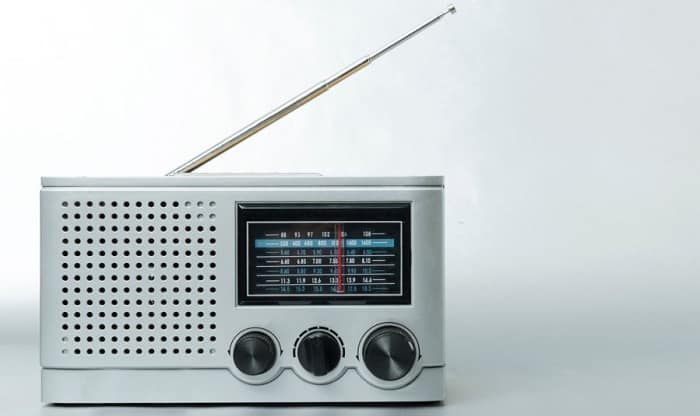From sports broadcasts to talk shows, AM radio is still common these days despite the emergence of smartphones and other modern equipment. However, because of its old technologies, it is prone to many problems, including static or noise.
When you hear a hissing or crackling sound, this means that you have a signal problem. To get better AM reception, change the radio’s position or use a new external antenna. You can even make one at home with a wire.
Read on to learn more about how to improve AM radio reception at home. Most solutions are pretty much common sense.
Table of Contents
What is AM Radio?
Before we start listing down the specific solutions, I will first talk about what an AM radio is. By knowing how it works, it is easier to track the issues and learn about what you can do.
AM stands for amplitude modulation. It is a radio broadcast that uses a frequency band ranging from 540 to 1610 kHz. Every channel has a space of 10 Hz, at least, in the United States. Modulation is done by varying its signal strength instead of frequency.
In an AM radio, the amplitude causes a difference in the signal. It needs to adapt to the sound waves being broadcasted. Any variation in the amplitude is noticeable, creating an audible static. The best solution for this is to enhance the reception.
As you change the channel in an AM radio, the amplitude change is audible. In case of a distant broadcast and a weak signal, the sound is faint. You will hear mostly static.
Today, manufacturers have tweaked radio technologies to offer better reception. However, they are not enough, especially in poor locations.
What You Will Need to Follow This Tutorial
Before I share some suggestion for a better AM reception, here are the things that you must have:
- External Antenna
- Wire
How to Improve AM Radio Reception at Home
It is frustrating when all that you hear is an unclear sound or shushing sound from the radio. Luckily, most of the solutions are quite easy, including those I will list below.
Step 1: Change the Position of the Radio
Relocating your radio is one of the simplest but most effective solutions to boost the signal. Listen to the radio on the different parts of the house and see where there is more static. Once the sound is clearer, you’ve found the perfect location.
Put the radio as close as possible to the transmitter. Concrete, steel, aluminum, and other obstructions will weaken the signal. Certain materials will block AM radio waves.
Keep the AM radio away from electronics, such as televisions, computers, and CD/DVD players. Remove any appliance that can cause signal interference.
Many things outside your home can also impede the reception. Especially when it is windy, hot, or dry, power lines can affect the AM radio. Salt, pollution, dust, or dew in an electrical line can also be a problem.
If there are street lights outside your home, it can also be a problem. Try to test the radio at night when the light is on and in the day when the light is off.
It also helps to know the position of the transmitting tower. Wherever it is, that is where the back of the radio must face. Facing in the opposite direction results in unclear frequency transmission. Remember, antennas are directional, so they won’t pick up signals that are on the opposite side.
Step 2: Check the Station Coverage
After changing the location, if the signal is still bad, check if the station you are trying to connect to is within the coverage area. A lot of AM stations are going out of business, so it may be hard to pick some signals.
Being too far from the transmitter means that the signal will not reach the radio. It is especially the case when there are buildings, hills, and other physical obstructions that weaken the signal travel. Check online coverage maps to be sure.
Step 3: Choose the Right Radio
In some instances, the radio itself is the source of the problem. You are probably using one with low quality, which is why it does not pick up a strong signal. Choose one that is made by a reliable company for improving AM radio reception.
Older radios are the analog model, which has been around for more than a hundred years. They move sine wave information to the receiver through a transmitter. It is user-friendly and affordable but prone to weather disturbances.
For more reliable and stronger signals, digital AM radios are good options. They have better reach to improve the overall sound quality. The main issue is that it is prone to lags.
Among others, one of the best options to consider is the Panasonic RF-2400D Radio. It is both an AM and FM radio, making it a great investment. It has a digital tuner with auto frequency control. The ferrite antenna is also a plus, which helps strengthen the signal.
Step 4: Change the Antenna
Even if your AM radio already comes with a built-in antenna, it may not be enough. There are limitations in terms of its reach, restricting the signals that it can pick up. It is a good idea to use an external antenna to boost AM radio signal.
One of the top products that should be on your radar is the Terk Indoor AM Antenna Advantage. The reception pattern is omnidirectional, with an output impedance of up to 300 ohms.
Meanwhile, if you are looking for one that you can use outdoors, a great alternative is the Herdio Waterproof Marine Antenna. Do not be discouraged by the word “marine” since it isn’t just for boats. You can also use it for cars and homes, among other applications.
Step 5: Make a DIY Antenna
Got no budget for buying a new antenna? Would you rather take the DIY route? With a little patience and basic materials, you can make an AM radio antenna. Watch this short video for a quick guide on how you can do this.
The main material that you will need is a roll of insulated wire. Put the wire in a high object, such as a tree. Extend the antenna as far as it goes until it reaches the radio. Wrap the wire on the radio and strip the end and put it in a stationary object. This will make a great AM radio antenna booster.
Step 6: Consult an Expert
Did you try the things above but none worked? The next best thing to do is to call an expert to check or repair the radio. Do not try to dismantle the radio yourself and fix the internal components.
An experienced radio repairman can effectively diagnose the problem. Some parts may need a replacement, especially if they have been prone to rust and corrosion.
Conclusion
While they seem obsolete these days, many people are still using an AM radio. However, it is prone to several issues, with one of the most common being the weak signal, resulting in hissing noise or static.
To improve AM reception, you will need a high-quality radio antenna. Alternatively, you can also make a homemade antenna using an insulated copper wire. More so, it is also best to change the radio’s location, which should be away from signal interference.
For more reliable performance, choose a reliable radio. One option worth considering is Panasonic RF-2400D Radio. In case you need a new antenna, I also recommend taking a look at Terk Indoor AM Antenna Advantage and Herdio Waterproof Marine Antenna.

After four years working as a radio mechanic, I know that everything about radio communication is not breezy, even though it greatly benefits us. That is why I set up a website sharing my skills and guides to help non-professional users use their radio headsets, set up their antennas or choose the right products, etc.




